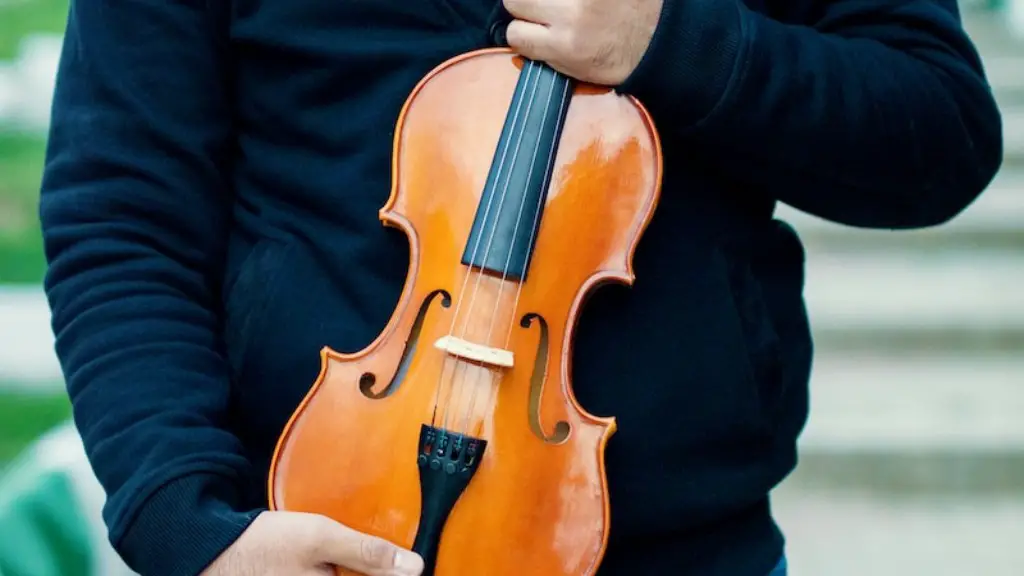The violin is a beautiful string instrument that has been around for centuries. It is known for its sweet and soulful sound, which is why it is a popular choice for classical music pieces. The sound of a violin is produced by the four strings being bowed or plucked. The body of the instrument also plays an important role in creating the unique tone of the violin.
The type of wood used to make the violin, as well as its size, shape and design all contribute to the tone of the instrument. The type of strings used also affects the sound, with steel strings producing a brighter sound than nylon strings.
A skilled violinist can produce an incredibly wide range of sounds on their instrument, from gentle and soothing melodies to dramatic and powerful riffs. By varying bowing speed and pressure, as well as fingering techniques, they can create a multitude of unique tones and timbres.
The emotionality of the violin’s sound has captivated audiences for centuries, making it one of the world’s most beloved instruments. Whether you are listening to a classical piece or an upbeat folk tune, you are sure to be moved by the sweet sound of the violin.
How Do Different Types of Strings Affect the Sound of a Violin
The type of strings used on a violin can have a dramatic effect on its sound. Different types of strings offer different levels of flexibility, brightness, and projection, all of which can influence the overall tone and volume produced by the instrument. Gut strings provide a warm, mellow tone with good volume and clarity. Steel strings provide a bright sound with excellent projection and sustain. Synthetic core strings provide good flexibility and brightness while producing a balanced sound across all registers. Finally, electric violin strings offer an even brighter sound that is highly articulated with lots of sustain.
No matter what type of strings are used, they should be well-maintained in order to achieve the best possible sound from the violin. This includes regular cleaning and tuning as well as replacing old or worn out strings when necessary. It is also important to find a string gauge that works for you; too light or too heavy can negatively affect the sound. Experimenting with different types and gauges of strings can help you find the perfect set for your instrument and playing style.
Ultimately, the type of strings you choose will determine how your violin sounds. Experimentation is key to finding the perfect string set for your instrument so that you can create the desired tone and volume.
How Does the Size of a Violin Affect Its Sound
The size of a violin has a major impact on its sound quality. Smaller violins produce a higher, more delicate sound while larger violins can produce a fuller, deeper sound. The size of the instrument also affects the volume and richness of sound produced. Smaller violins can be ideal for playing solo music because they have a softer tone that can help to create an intimate atmosphere. Larger violins, however, are better suited for playing in larger ensembles because their fuller sound can be heard more easily in bigger spaces.
The type of wood used to make the violin also affects its sound quality. Softwood such as spruce will produce a brighter tone, whereas hardwood such as maple will create a darker and warmer tone. The type of strings used on the violin will also affect its sound. Synthetic strings are typically used on student-grade instruments and create a brighter tone with better intonation than gut strings. Professional-grade string instruments usually have gut strings to create an authentic and warm sound with excellent tonal quality.
Ultimately, the size of the violin is one of many factors that influence its overall sound quality. A well-made instrument with good materials will produce superior sound regardless of size, but experimenting with different sizes may help you find the right instrument for your style and taste!
How Does Bow Pressure Affect the Sound of a Violin
The sound of a violin is greatly impacted by the amount of pressure applied by the bow. When applying more bow pressure, the sound produced is louder and more intense. On the other hand, less pressure results in a softer, warmer sound. The amount of pressure applied can also affect the tone and resonance of the violin. With heavier bow pressure, each note will be brighter and have a longer sustain, while lighter pressure produces a mellower tone. It is important to use just enough pressure so that each note is heard clearly without causing any unwanted buzzing or rattling noises. Practice and experimentation are key to finding the perfect balance between volume and tone. The same amount of bow pressure should be used throughout an entire piece for consistent sound production.
Bowing Techniques and Violin Sound Production
The sound of the violin is a product of the bowing techniques employed by the musician. Different techniques are used to produce a variety of sounds, from mellow and smooth to sharp and aggressive. The most common bowing techniques are legato, staccato, tenuto, vibrato, and portamento. Each technique has its own unique qualities which can be used to create distinct sounds on the violin.
Legato is a smooth, connected bow stroke that produces a gentle sound. It is often used for lyrical passages or for slow movements. Staccato is a crisp, disconnected bow stroke that produces a sharp and lively sound. Tenuto is an expressive bowing technique that emphasizes certain notes in order to create subtle nuances in the music. Vibrato is an undulating bow stroke that adds warmth and expressiveness to the music. Finally, portamento is a sliding bow stroke that allows for smoother transitions between notes.
By combining these different bowing techniques, musicians can create a wide range of sounds on the violin. Some musicians even use more unorthodox techniques such as slapping or double-stopping in order to produce unique sounds. The possibilities are only limited by one’s imagination and skill level! With practice and experimentation, any musician can unlock their creative potential with these various bowing techniques.
What Factors Affect the Resonance and Tone of Notes Played on the Violin?
The sound of a violin is determined by several factors, including the size and shape of the instrument, the type of wood used, and how it is strung. The size and shape of the violin affects its resonance and tone, as does the type of wood used in its construction. The thickness of the strings also has an influence on how it sounds, with thicker strings producing a brighter sound. Additionally, the quality of rosin used on the bow can affect resonance by providing more friction to create a richer tone. The player’s technique also has an impact on how a violin sounds; proper posture and bow technique can produce a better sound than improper technique. Finally, a good quality instrument will produce fuller tones than one that is not as well-made.
In order to achieve optimal sound quality on a violin, it is important to ensure that all these factors are taken into account. By selecting high-quality materials and having proper maintenance, musicians can make sure that their instrument produces beautiful tones every time they play.
How Is Vibrato Used to Create Different Sounds on the Violin
Vibrato is a technique used by violinists to create different sounds on their instrument. It involves rapidly changing the pitch of a note by altering the tension of the finger that is pressing down on the string. This can be done by pushing and pulling on the finger while playing, or by using a vibrato arm attached to the instrument. Vibrato adds expression to a note, and can be used to create a wide range of tonal effects, from subtle nuances to dramatic changes in sound. When used in combination with other techniques such as slides, ornaments and vibrato can help bring out different aspects of the violin’s sound. In order for vibrato to sound effective it must be used with precision and skill; otherwise it will sound too forced or unnatural. By mastering this technique, violinists can create beautiful and unique sounds.
The End
A violin produces a beautiful and unique sound that is unlike any other instrument. The sound of a violin is often described as warm and mellow yet powerful and passionate. It can range from soft, delicate tones to strong, robust notes. The player’s ability to control the instrument, combined with their own musical expression, allows them to create an endless variety of sounds. No matter how it is interpreted, the sound of a violin can be truly captivating.




